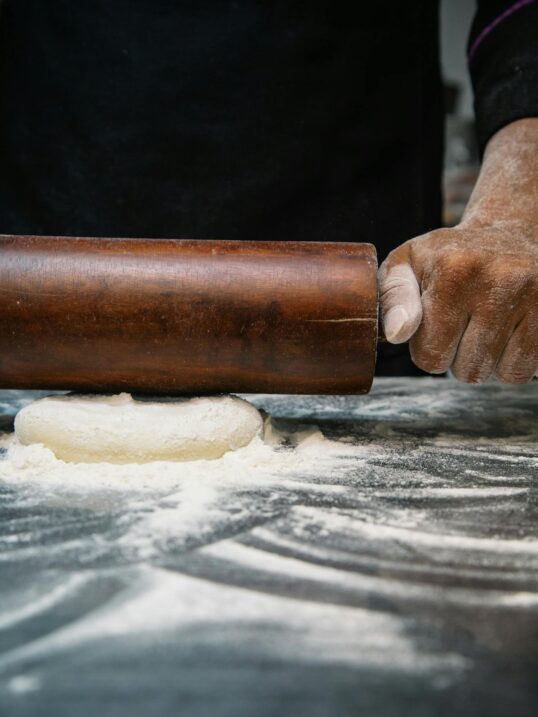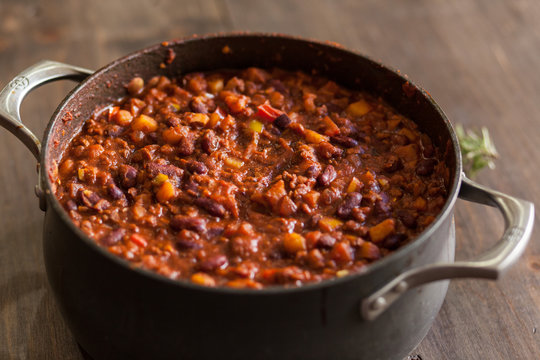Cornmeal and cornstarch are distinct corn derivatives. Cornmeal adds texture and flavor to dishes like bread and polenta, while cornstarch thickens sauces and soups without altering flavor. Their differing textures and culinary uses impact recipes uniquely.
This blog will help you understand the differences between cornmeal and cornstarch, discuss popular recipes, and share practical tips on substitutions – including what works and what doesn’t.
What is Cornmeal?
Cornmeal is the flour you get when you grind dried, whole corn kernels. Depending on the type of corn used, cornmeal can be yellow or white.
Typically, a corn kernel consists of a fiber-rich outer covering called bran, or pericarp; a starchy inner substance called the endosperm; and an oil and nutrient-rich germ, the kernel’s living part.
The types of processing corn kernels are put through yield very different textures of cornmeal, ranging from coarse to medium to fine. Stone-ground cornmeal includes the fibrous exterior of the kernel, resulting in a coarse texture, and is a whole-grain flour.
On the other hand, cornmeal milled between metal rollers has a finer texture. To achieve this, some manufacturers partly remove the bran before the corn goes through milling. This additional step not only produces finer flour but also improves its shelf life.
While whole-grain cornmeal typically lasts between six to nine months, removing bran before grinding increases shelf life by at least a year.
Cornmeal is the primary ingredient for various porridge recipes, such as Italian polenta and Southern-style grits. It is used to make gluten-free dough for pizza, bread, muffins, and much more.
Cornmeal is also ideal for coating chicken, fish, vegetables, or even cheese sticks before deep frying or baking them, as it adds a delicious, crispy layer and a distinct corn flavor.
What is Cornstarch?
Cornstarch is a fine, powdery flour obtained by processing the starchy endosperm of corn kernels rich in carbs, while also gluten-free.
Unlike cornmeal, cornstarch is always white and has an extremely fine texture.
Cornstarch is practically flavorless, and its starchy composition makes it well-suited for use as a thickener in soups, stews, and gravy-based dishes, and to prepare thick fillings or toppings, such as lemon curds for cakes and cupcakes, blueberry or other fruit-based sauces for cheesecake toppings, and lots more.
Cornstarch can also be used as a binding agent in cookies, while sauces that incorporate cornstarch coat food items evenly, which makes dishes look more put-together.
This ingredient also works in a pinch to make a gluten-free roux for bechamel sauce. Owing to its nil protein content, cornstarch can also be used to improve the texture of gluten-free bakes, making them lighter and fluffier.
Are Cornmeal and Cornstarch the Same?
Cornmeal and cornstarch are not the same. Cornmeal is ground from whole corn kernels, including bran, starch, and germ, providing fiber and nutrients. Cornstarch is made from only the starchy part of the kernel, containing no protein or fat.
Therefore, cornmeal is a whole-grain flour, while cornstarch falls under the refined flour category. However, it is important to note that when used in small quantities as a thickener or a binder, or when mixed with other types of flour in gluten-free bakes, cornstarch does not rob food of its nutritional value.
Differences Between Cornmeal and Cornstarch
The main difference between cornmeal and cornstarch is the texture. Cornmeal has a gritty texture; although it is possible to produce finer flour by removing some of the fibrous hulls. The corn used to produce cornmeal is mostly dent corn or field corn, which is different from sweet corn, popular as corn on the cob.
Color
Cornmeal comes in a range of hues, from light blue to bright golden; dull straw to white, which entirely depends on the variety of corn used.
On the other hand, cornstarch is always finely ground and white. Another tip to distinguish between cornstarch and cornmeal: cornstarch lets out a ‘squeak’ when you rub it between your fingers; you can’t do the same with cornmeal.
Taste
Cornmeal adds an earthy flavor to dishes. Yellow cornmeal provides a richer taste than white cornmeal, and cooking intensifies its flavor.
Cornstarch doesn’t taste like corn and its mild, starchy flavor entirely disappears when cooked, which complements its function as a thickener.
Nutrients
Cornmeal is a whole-grain, gluten-free flour that contains a rich blend of proteins, fats, carbs, fiber, and other nutrients, such as selenium, magnesium, and potassium, to name a few.
Cornmeal that’s been stripped of its nutrients during processing could be fortified to boost its nutritional value.
However, cornstarch is all carbs and is a gluten-free, refined flour. Unlike cornmeal, which is a staple food, cornstarch serves more like an enhancer, added to foods to improve its consistency and stability.
Cornstarch cannot replace whole-grain flour as part of a healthy, balanced diet and must be used in moderation in cooking.
Cooking and baking uses
Cornmeal is more famously associated with porridges, such as polenta and grits, and cornbread. It can also be used in gluten-free bakes, such as corn muffins, cookies, cakes, and many more.
In Mexican cooking, corn kernels are treated by soaking them in an alkaline solution to make them softer. The flour produced from treated corn called masa harina, can be kneaded into a dough and is used to prepare Mexican tortillas, tamales, etc.
Cornmeal is also used for breading fish, chicken, and veggies before frying. Its coarse texture also makes it suitable as a release agent for pizzas and breads.
Cornstarch, on the other hand, is used to thicken soups, sauces, and gravies. To do this, a cornstarch slurry is prepared by mixing equal parts cornstarch and cold water until no lumps remain.
This slurry is added to the dish in the final stages of cooking. Once the liquid thickens, it is essential to stop cooking, as overboiling produces the reverse effect and can thin down the liquid.
Cornstarch can be added in small quantities to pie fillings and cake toppings to firm them up. Confectioner’s sugar contains cornstarch as an anticaking agent. The presence of cornstarch is why confectioner’s sugar can be whipped up with butter into a firm buttercream to frost cakes and make decorations.
Coating a thin layer of cornstarch improves the crispiness of deep-fried, stir-fried, and baked foods and is a common practice in Chinese cuisine.
How to Substitute Cornmeal for Cornstarch and Vice Versa
Given their different composition and properties, it is not recommended to substitute cornmeal for cornstarch or vice versa.
In recipes that call for coarsely ground cornmeal, semolina or durum wheat flour makes a good substitute, owing to their similar textures. However, do remember that semolina is not gluten-free.
Finely ground cornmeal or corn flour can be replaced with equal portions of light buckwheat flour, sorghum flour, or oat flour.
When it comes to cornstarch, you can substitute one part cornstarch with one part potato starch or arrowroot powder; or two parts wheat flour (all-purpose flour), rice flour, or tapioca starch.
| Feature | Cornmeal | Cornstarch |
| Source | Made from whole corn kernels (bran, germ, and endosperm). | Made from the starchy endosperm of corn kernels. |
| Texture | Coarse to fine, depending on processing. | Extremely fine, powdery texture. |
| Color | Varies from yellow, white, or blue, depending on the corn variety. | Always white. |
| Flavor | Earthy, pronounced corn flavor. Cooking enhances its flavor. | Mild, starchy flavor that disappears when cooked. |
| Nutrients | Whole-grain, gluten-free, rich in protein, fiber, and nutrients like magnesium and potassium. | Gluten-free, refined flour made of carbs, with no protein, fat, or fiber. |
| Primary Use | Main ingredient in porridges (polenta, grits), cornbread, and gluten-free baking. | Thickening agent for soups, sauces, and gravies; improves texture in gluten-free baked goods. |
| Other Uses | Breading for fried or baked foods, release agent for pizza dough, and base for masa harina dishes. | Anti-caking agent in confectioner’s sugar, crisping agent for frying, and binder for desserts. |
| Cooking Method | Requires longer cooking times; adds structure and texture to dishes. | Added as a slurry (mixed with cold water) to thicken dishes near the end of cooking. |
| Substitutions | Substitute with semolina, light buckwheat, sorghum, or oat flour (not all gluten-free). | Substitute with potato starch, arrowroot powder, wheat flour, rice flour, or tapioca starch. |
| Shelf Life | 6–9 months for whole-grain cornmeal; over a year for de-branned cornmeal. | Long shelf life if stored in a cool, dry place. |
| Notable Recipes | Cornbread, polenta, grits, muffins, tortillas, and tamales. | Soups, gravies, pie fillings, cake toppings, stir-fried dishes, and roux for gluten-free sauces. |
Insider’s Insight
Cornmeal is produced by grinding whole corn kernels, whereas cornstarch is extracted from the carb-rich endosperm of the kernel.
Cornmeal is a nutritious, whole-grain flour used as a primary ingredient to make porridge, cornbread, and gluten-free bakes and comes in varying textures and colors.
The flour has a pronounced corn flavor and lends structure to breads, muffins, quiches, and cakes.
By contrast, cornstarch is a fine flour that is used as a thickener, anti-caking agent, and breading ingredient. In baking, cornstarch is added in small quantities to all-purpose flour to improve the fluffiness of baked goods. Cornstarch has a mild, starchy flavor that all but disappears on cooking.
Cornmeal and cornstarch are both gluten-free and are incredibly useful ingredients to have in your pantry. However, keep in mind that one cannot be substituted for the other as they cook and bake differently, have different nutritive values, and impart different flavors and textures to dishes. Happy cooking!



